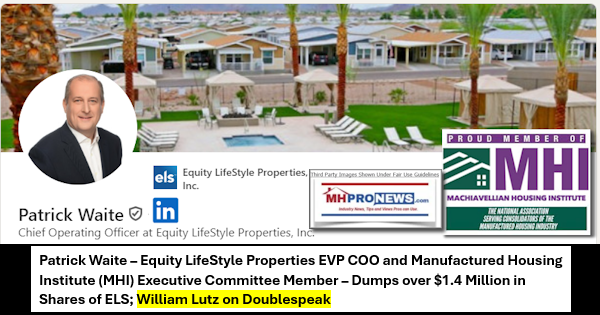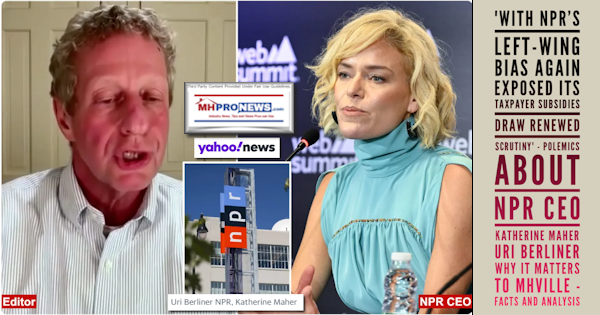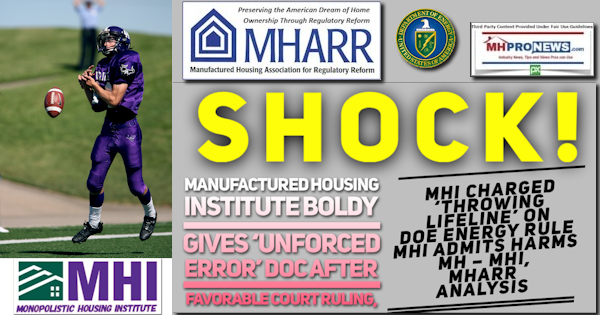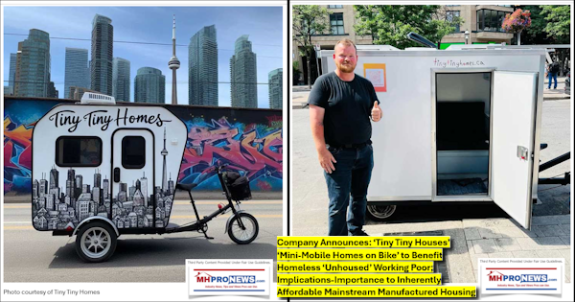“Manufacturers believe they can pick up the pace of production even more, but…a final rule from the Department of Energy [DOE] on energy efficiency requirements is set to drop in May that could add significant friction to getting new homes out the door,” said Texas Manufactured Housing Association’s (TMHA) VP Rob Ripperda. “The factory-built model only works when you can source your materials at scale. If a standard product is no longer allowed because of a regulatory change and the mandated substitute isn’t available at the necessary quantities, you’ve got the makings of a slowdown.” TMHA is an MHI affiliate, which is to say they are pro-MHI. The context for that sobering comment by Ripperda plus additional facts, statements and analysis are linked here. Ripperda’s TMHA observation is apt, as MHI and the Manufactured Housing Association for Regulatory Reform (MHARR) superficially appear to be in agreement that the looming DOE proposed rule would be costly and harmful. The DOE rule, argues MHI and MHARR, could block millions of potential consumers of consumers by pricing them beyond their ability to pay for or finance at an affordable payment. As another industry Manufactured Housing Executive Committee (MHEC) member told MHProNews, “manufactured housing would no longer be affordable for millions.”
Put simply, there is broad superficial agreement among industry professionals that the DOE rule will harm manufactured housing affordability. That could in turn harm independent producers, thus cost jobs and also sellers. The cascade effects harm homebuyers. As our Sunday report on Realtor’s Danielle Hale highlighted, there are broader impacts on the overall housing market.

For a broader context, supporters of the DOE rule are examined in the report linked here.
The genesis of the fierce debate within the manufactured housing industry ranks is linked here and here.
Some of this may seem subtle. Grasping what has occurred in roughly the past two weeks absolutely requires an attention to detail.
This Masthead report, analysis and commentary will do what MHProNews has routinely done for some years. Namely, provide the source materials necessary for an objective reader to see if the claims and analysis offered are supported by the evidence.
So, this MHProNews Masthead will include:
- MHI’s 3.2.2022 ‘news’ item.
- MHI’s recent DOE filing, which their news item provided, and which was provided to MHProNews.
- Both MHARR March 2022 news items, including a connected document provided to DOE in response to the MHI regulatory filing.
- Pull quotes based upon source materials.
- Other evidence also based upon source materials.
What is “shocking,” as the headline touts?
- That MHI’s own letter to DOE and their statements to their members are blatantly self-contradictory.
- What MHARR has done for the industry is to broadly point out that MHI is openly throwing the DOE a possible “lifeline” after MHI themselves state why the DOE rule is harmful. The proposed rule should be rejected outright.
- While the featured illustration suggests a fumble, this is more like tossing the proverbial football directly into DOE’s hands – a kind of intentional pass interception.
- That’s either dumb (inept, incompetent, whatever descriptor someone wants to plug in and use for nonsensical behavior), OR it reveals the duplicitous behavior of MHI for all with eyes and intellect to see.
We’ve long held editorially that MHI’s leaders are intelligent people. For instance, MHI now has TWO, not one Ph.D.’s on staff.
MHI’s past and present board is dominated by larger brands that often have decades of manufactured experience in their ranks.
- But MHI’s board has also been dominated for some years by apparent consolidators.
What explains MHI’s odd behavior? The case can be made that MHI in their latest DOE filing is blatantly doing what MHARR alleged. Namely, providing a lifeline after MHARR has once again apparently formed the basis for killing the latest iteration of this rule process that MHI admits is harmful.
Simply stated. MHI can’t have it both ways. If they are seriously fighting a battle that could cause the death of jobs, businesses, and the hopes of potentially millions to own an affordable home of their own, then MHI should not throw their DOE opponent a lifeline.
How MHI has seemingly done precisely that, using their own words, will be explored in this report, analysis and commentary.
After the MHI elements as noted herein will be both MHARR press releases to date from March 2022. Thus, objective readers seeking the truth will have all of the evidence used in this report, fact check, analysis and commentary. “We Provide, You Decide.” ©
Notice: showing MHI content or logo should not be construed as an endorsement. They are here for the specific purpose of discerning the facts of the competing claims and logic, or lack thereof, of MHI’s stance.
MHI’s 3.2.2022 News & Update
News from Washington
MHI Proposes Alternative Energy Efficiency
Standards to DOE
As part of its comprehensive strategy with the Administration and the Department of Energy (DOE) about energy efficiency standards for manufactured housing, MHI and the industry again reiterated its commitment to supporting energy efficiency conservation efforts and other reasonable environmental protection initiatives so long as they are cost effective and are feasible for the industry from a construction and transportation standpoint. Towards that effort, MHI, in addition to ongoing meetings and outreach, submitted another official comment letter in response to the DOE’s draft Environmental Impact Statement (EIS), which evaluates potential impacts of the Department’s proposed action to establish energy efficiency standards for manufactured housing. MHI’s letter provides an alternative technical proposal for energy efficiency manufactured housing standards focused on improvements that would be feasible in the factory-built environment. Developed by MHI, its members and other industry experts, the technical proposal makes changes to the original DOE proposal that would result in a final rule that achieves the legislative goal of increased energy efficiency, without threatening low- and moderate-income families with losing the most affordable homeownership option in America, manufactured housing, as a result of excessive cost increases and feasibility challenges in the proposed standard.
MHI also argued in its comment letter that the proposed standards do not take into consideration current construction methods and transportation requirements, or testing and compliance requirements. Therefore, the impact of the proposal on consumers and the industry is clearly and significantly underestimated in the EIS both with respect to the expected increase in costs and overall feasibility. Further, MHI states that the proposed rule raises a wide range of legal, policy, environmental, and implementation questions citing a recent court injunction blocking the Administration from using the use of “Social Cost of Carbon” estimates in federal rulemaking. It also fails to comply with the statutory requirement to be cost effective and to adopt a more stringent standard when it would be cost effective. Finally, the proposed rule fails to consult with HUD, as required by statute, and to address the primacy of the HUD Code and the Manufactured Housing Consensus Committee’s role in establishing safety and construction standards.
More than 300 comments were submitted as a result of MHI’s Call to Action including letters from state associations, individual company letters, and member responses. Since the release of the proposed rule, MHI has been working with the DOE and the Administration to ensure that any manufactured housing energy efficiency changes are feasible for manufactured housing and will not hurt the availability of manufactured homes for homebuyers.
MHI will continue to actively engage with the DOE and Administration to ensure any manufactured housing energy efficiency standards do not harm this affordable homeownership option. Click here to read MHI’s letter. ##
MHI Comments Analysis
Let’s unpack those MHI remarks. After months of posturing opposition MHI’s claimed opposition to this DOE energy rule they, Ripperda at TMHA, MHARR, and others have called harmful, MHI themselves stated they are proposing an alternative. What are they thinking? Quoting MHI from the above:
A) “Therefore, the impact of the proposal on consumers and the industry is clearly and significantly underestimated in the EIS both with respect to the expected increase in costs and overall feasibility.”
B) “Further, MHI states that the proposed rule raises a wide range of legal, policy, environmental, and implementation questions citing a recent court injunction blocking the Administration from using the use of “Social Cost of Carbon” estimates in federal rulemaking.”
Note: If there are legal, feasibility and even higher costs than are being estimated, then why is MHI offering (yet another) possible roadmap to allow DOE to press for more costly manufactured homes?
But that is obviously what MHI’s own words mean:
C) “MHI Proposes Alternative Energy Efficiency Standards to DOE”
D) “As part of its comprehensive strategy with the Administration and the Department of Energy (DOE) about energy efficiency standards for manufactured housing, MHI and the industry again reiterated its commitment to supporting energy efficiency conservation efforts and other reasonable environmental protection initiatives so long as they are cost effective and are feasible for the industry from a construction and transportation standpoint.”
a) There is in one sense no reason to go further. MHI is blatantly and boldly admitting – even in their cover message – what they are doing. If MHI truly opposed this rule, they should simply move to ‘kill it.’
b) Killing the rule is what MHARR has aimed at doing. Both MHI and MHARR have said that manufactured homes are ALREADY energy efficient. Both admit that consumers can option in “energy star” or other upgraded insulation standards. MHI says that some 30 percent of manufactured home buyers are already buying such enhanced energy efficient homes that go above already energy saving measures.
c) What this recent statement means is that MHI has essentially confirmed months of MHProNews reporting and analysis on this heated topic.
d) But further, MHI is not only tossing the DOE “a lifeline” as MHARR has asserted, which will be shown below. MHI is also giving ammunition to the enemies and competitors of our industry. MHI’s claims are logically self-contradictory on its face. Then by giving “a lifeline” to DOE, they are de facto admitting there is something to fix. That’s wrong. By MHI saying there is a path that DOE could follow is mistaken, because the path that MHI is offering is also costly. It is a self-contradictory stance. The MHI offered path must therefore be rejected.
e) One of the points MHProNews has raised in our analysis is that consumers are being threatened with a loss of choice. Why not let consumers decide how much energy saving features they want to pay for when they buy a new manufactured home?

f) That is precisely what MHARR has done. Let’s examine what MHARR has said in their emails, and then circle back to some additional points from MHI’s underlying document and related information.
g) Note that the MHARR email below was sent the day before the MHI email, above.

MHARR ASSERTS NEW ARGUMENTS FOR
WITHDRAWAL OF DOE ENERGY RULE
Washington, D.C., March 1, 2022 – In its continuing effort to oppose the unnecessary and costly manufactured housing energy standards rule proposed by the U.S. Department of Energy (DOE), the Manufactured Housing Association for Regulatory Reform (MHARR) has filed comments (attached) opposing the use of a Draft Environmental Impact Statement (Draft EIS) published by DOE on January 14, 2022, in connection with that rulemaking. The Draft EIS, required by the National Environmental Policy Act (NEPA), is one of the few remaining steps in the administrative process for the development of a final DOE energy standards rule, and represents what could be one of the last opportunities for the industry and consumers to submit administrative-level comments opposing the rule.
First, the comments fully set forth MHARR’s position that the entire DOE manufactured housing energy rulemaking, including proceedings related to the Draft EIS are, in fact, stayed and enjoined under a preliminary injunction issued February 11, 2022 by the United States District Court for the Western District of Louisiana in Louisiana v. Biden, Case No. 2:21-CV-01074, barring DOE and other federal defendants from using “Social Cost of Carbon” values in pending and future rulemaking activities. As MHARR initially advised DOE on February 16, 2022, both the Memorandum Ruling issued by the court and subsequent filings by the U.S. Department of Justice (DOJ), make it abundantly clear that not only is DOE generally subject to that injunction, but is also, by DOJ’s admission, specifically enjoined with respect to the DOE manufactured housing energy standards rulemaking. As a result, the DOE manufactured housing energy standards rulemaking, by law, cannot and should not proceed pending final action by either the District Court or a higher-level court.
Second, however, in the event that the court’s current injunction is either stayed or invalidated, and the pending rulemaking proceeds, MHARR’s comments object to the substance of the Draft EIS. Most significantly, MHARR’s findings show that the proposed DOE energy standards are wholly, completely and totally inappropriate for, and inapposite to, today’s modern, affordable post-2000 reform law manufactured homes, which constitute legitimate housing for all purposes, and are instead targeted at the “trailers” of the past, which no longer exist – as is shown by the trendline of manufactured housing energy cost data, which is now below the trendline for site-built homes for all fuel types (i.e., oil, electricity and natural gas).
Furthermore, the Draft EIS, as shown by MHARR’s comments, totally fails to consider the extent and impact of significant individual and societal costs that would flow from the proposed rule including, but not limited to: (1) direct individual and societal-level opportunity and related costs for the millions of Americans who would be excluded from homeownership by the purchase price increases necessitated by the proposed rule; (2) downstream societal costs resulting from the exclusion of millions of Americans from homeownership as a result of purchase price increases necessitated by the proposed rule including, but not limited to: forced utilization of substandard housing; forced utilization of unsafe or unhealthy housing; forced utilization of taxpayer-subsidized housing; physical and/or mental illness resulting from (or exacerbated by) homelessness or housing poverty and related costs; and increases in crime and criminal activity; and (3) failure to consider the diminution of alleged benefits of the proposed rule as a result of the rampant market exclusion of lower-income buyers, among other things. By contrast, if DOE had bothered to fully comply with the express terms of both EISA and the 2000 reform law, it would have gone through the proper procedures to arrive at a legitimate, valid and workable standard for the unique characteristics and affordability of today’s modern manufactured housing, in accordance with section 604 of the Act, rather than nearly two decades of wasted time.
By failing to consider – at all – these and other predictably-significant individual and domestic societal costs of the proposed rule, while simultaneously attempting to pad the rule’s alleged “benefits” with global carbon reduction assumptions, the Draft EIS simultaneously understates the costs of the proposed rule while it overstates its alleged benefits contrary to NEPA, the federal Administrative Procedure Act and other applicable law. These fundamental failures, moreover, are in addition to and further exacerbate fatal defects throughout the DOE rulemaking progress, as addressed by MHARR in its previous comments in this matter. As a result, MHARR’s Draft EIS comments call on DOE to withdraw the proposed rule and to instead partner with HUD in a legitimate rulemaking, targeted at the valid energy needs of actual manufactured housing consumers, instead of extremist environmental “activist” groups.
The Manufactured Housing Association for Regulatory Reform is a Washington, D.C.-based national trade association representing the views and interests of independent producers of federally-regulated manufactured housing. ##
MHARR Comments – Facts and Analysis
Let’s unpack some key points. Quoting, as this MHProNews Masthead analysis of MHARR’s remarks, as was provided above with respect to MHI’s remarks:
A) “First, the comments fully set forth MHARR’s position that the entire DOE manufactured housing energy rulemaking, including proceedings related to the Draft EIS are, in fact, stayed and enjoined under a preliminary injunction issued February 11, 2022 by the United States District Court for the Western District of Louisiana in Louisiana v. Biden, Case No. 2:21-CV-01074, barring DOE and other federal defendants from using “Social Cost of Carbon” values in pending and future rulemaking activities.”
- The MHProNews Masthead notes that MHARR is saying, unless some higher court relents, this could be ‘game over’ for the DOE rule. If so, that begs the question – why is MHI offering what MHARR later called ‘a lifeline’ to DOE?
- To the point, if a higher court relents on the DOE stay imposed by the Louisiana v. Biden case, MHARR continues by saying the following.
B) “…in the event that the court’s current injunction is either stayed or invalidated, and the pending rulemaking proceeds, MHARR’s comments object to the substance of the Draft EIS. Most significantly, MHARR’s findings show that the proposed DOE energy standards are wholly, completely and totally inappropriate for, and inapposite to, today’s modern, affordable post-2000 reform law manufactured homes, which constitute legitimate housing for all purposes, and are instead targeted at the “trailers” of the past, which no longer exist – as is shown by the trendline of manufactured housing energy cost data, which is now below the trendline for site-built homes for all fuel types (i.e., oil, electricity and natural gas).”
- The Masthead notes that the MHARR’s comments are shrewdly aware that others are watching this process unfold. They have therefore made a bright line distinction between “the “trailers” of the past, which no longer exist” and the modern and affordable manufactured homes “which constitute legitimate housing for all purposes.” MHI claims to represent “all segments” of the industry, and they claim they promote the industry. Then why aren’t they defending the industry’s good name in their comments in as clear a fashion as production focused MHARR has done?
C) “the Draft EIS, as shown by MHARR’s comments, totally fails to consider the extent and impact of significant individual and societal costs that would flow from the proposed rule…”
- Note that MHARR’s comments the day before MHI’s provided a possible roadmap for what MHI could have done. But MHI clearly rejected the MHARR path, opting instead to give DOE – as MHARR later argued “a lifeline” when all of the facts each presented argued against giving the DOE anything other than a reason to scrap the entire and ‘fatally flawed’ process, as MHARR has previously dubbed it.
- What follows is the next MHARR statement released in their email dated 3.10.2022.

MARCH 10, 2022
TO: MHARR MANUFACTURERS
MHARR STATE AFFILIATES
MHARR TECHNICAL REVIEW GROUP (TRG)
FROM: MHARR
RE: MHARR FILES COMMENTS CLARIFYING MHI’S PRESUMPTIVE
STATEMENT REGARDING PROPOSED DOE ENERGY STANDARDS
The Manufactured Housing Association for Regulatory Reform (MHARR) has filed supplemental comments with the U.S. Department of Energy (DOE) in its rulemaking docket for a Draft Environmental Impact Statement (EIS) concerning proposed manufactured housing “energy conservation” standards. MHARR’s supplemental comments (copy attached), filed on March 4, 2022, correct and clarify inaccurate and presumptive characterizations contained in a so-called “Industry Proposal for Energy Efficiency Standards for Manufactured Housing,” attached as an “Appendix” to last-minute comments filed in the same rulemaking docket by the Manufactured Housing Institute (MHI).
In relevant part, “Appendix I” to MHI’s comments states that “MHI and the industry…” developed an “alternative manufactured housing energy standard” as set forth in the Appendix, “to provide a concrete example showing how a judicious increase in energy requirements can result in substantially improved energy efficiency and greater affordability.” (Emphasis added).
MHARR’s supplemental comments strongly object to any characterization of the MHI proposal as an “industry” initiative. First, MHI does not represent the entire manufactured housing “industry.” Any characterization of the MHI “alternative” standards proposal as an “industry” proposal, therefore, is false and misleading. Second, as MHARR’s initial comments in the Draft EIS rulemaking and in the preceding DOE manufactured housing energy standards rulemaking show, mainstream, modern HUD Code manufactured homes are already energy efficient, with average monthly energy costs below those of site-built homes for all tracked energy types. There is no basis, rationale, or need, accordingly, for an “increase” in manufactured housing energy requirements — “judicious” or otherwise – and no representative of any part of the industry should state, suggest, or imply otherwise, particularly when DOE’s energy proposal fails to meet the statutory criteria of both the Energy Independence and Security Act of 2007 or the Manufactured Housing Improvement Act of 2000.
MHARR acted immediately to disavow and correct this presumptuous misstatement insofar as it represents yet another in a string of strategic errors (including, but not limited to, one-sided procedural and substantive “compromises”) that have enabled DOE regulators to sidestep full compliance with EISA, the 2000 reform law and other applicable law, while repeatedly proposing draconian and destructive standards that would undermine manufactured housing as the preeminent source of non-subsidized, affordable homeownership for lower and moderate-income American families.
Particularly in light of the recent decision in Louisiana v. Biden, imposing a nationwide injunction against the DOE rule and others which rely in part on federal estimates of the “Social Cost of Carbon,” now is not the time to throw an undeserved “lifeline” to DOE regulators.
MHARR will continue to carefully monitor ongoing activity with respect to both the DOE manufactured housing energy rule and the related pending Social Cost of Carbon litigation, and will provide further updates as warranted. These matters will also be addressed in detail at the upcoming MHARR Board of Directors meeting.
cc: Other Interested HUD Code Manufactured Housing Industry Members and Consumer Groups … ##
MHARR Publicly Rebuked and Spanked MHI
Almost every word from the above is relevant and on point with the widely agreed upon point from manufactured housing industry professionals that the DOE proposals is demonstrably harmful to consumers, industry, and jobs. MHI’s phrasing and logic are both soundly and publicly rebuked by MHARR.
MHARR states that MHI does not represent everyone in the industry, as their statement to DOE reflected.
A) “MHARR’s supplemental comments strongly object to any characterization of the MHI proposal as an “industry” initiative. First, MHI does not represent the entire manufactured housing “industry.” Any characterization of the MHI “alternative” standards proposal as an “industry” proposal, therefore, is false and misleading.”
B) “Second, as MHARR’s initial comments in the Draft EIS rulemaking and in the preceding DOE manufactured housing energy standards rulemaking show, mainstream, modern HUD Code manufactured homes are already energy efficient, with average monthly energy costs below those of site-built homes for all tracked energy types. There is no basis, rationale, or need, accordingly, for an “increase” in manufactured housing energy requirements — “judicious” or otherwise – and no representative of any part of the industry should state, suggest, or imply otherwise, particularly when DOE’s energy proposal fails to meet the statutory criteria of both the Energy Independence and Security Act of 2007 or the Manufactured Housing Improvement Act of 2000.”
- The MHARR emailed memo included their statement to DOE dated 3.4.2022. It said the following.

March 4, 2022
VIA ELECTRONIC SUBMISSION
U.S. Department of Energy
Office of Energy Efficiency and Renewable Energy
Building Technologies Program
1000 Independence Avenue, S.W.
Washington, D.C. 20585
Re: Draft Environmental Impact Statement for Proposed Energy
Conservation Standards for Manufactured Housing (DOE/EIS 0550)
Dear Sir or Madam:
The Manufactured Housing Association for Regulatory Reform (MHARR) filled comments in this docket on February 25, 2022 opposing the Draft Environmental Impact Statement (EIS) published by the U.S. Department of Energy (DOE) on January 14, 2022. MHARR also filed comments on October 25, 2021 and November 22, 2021 opposing the proposed manufactured housing energy standards published by DOE on August 26, 2021 and modified on October 26, 2021.
On February 28, 2022, another manufactured housing industry group, the Manufactured Housing Institute (MHI), filed comments in the present docket. Among other things, those comments include and incorporate a document captioned “Appendix I – Industry’s Proposal for Energy Efficiency Standards for Manufactured Housing.” In part, that document states: “MHI and the industry’s goal in developing this alternative manufactured housing energy standard was to provide a concrete example showing how a judicious increase in energy requirements can result in substantially improved energy efficiency and greater affordability.”
We are writing to ensure that the administrative record is abundantly clear that:
(1) MHI does not represent the entire manufactured housing industry;
(2) MHARR was not consulted with respect to the aforesaid misnamed “industry” proposal;
(3) MHARR does not support or endorse the aforesaid misnamed “industry” proposal and would not support its adoption or consideration; and
(4) MHARR, as set forth in its previously-filed comments, would not accept or support any proposed manufactured housing “energy conservation” rule that is developed outside of the Manufactured Housing Consensus Committee process prescribed by the Manufactured Housing Improvement Act of 2000.
We ask that this communication be included in the administrative record of the aforesaid proceeding in order to prevent any misrepresentation or misunderstanding regarding alleged “industry” support for the aforesaid MHI “Appendix 1” document.
Sincerely,
Mark Weiss
President & CEO ##
MHProNews uniquely led the charge among all manufactured housing industry publishers and/or bloggers who have ignored the obvious evidence provided in the report linked below. That evidence is provided in documents that MHI has surreptitiously provided DOE years earlier documents that made clear that they want a new energy rule. Previously, MHI said one thing, but did another behind the backs of their own members.

In this most recent memo, MHI has for whatever reasons deliberately provided their members in their own words their now open effort to get a new energy rule. As MHARR pointed out, any energy rule has to go through the Manufactured Housing Consensus Committee (MHCC) process. That process is not only required by the Manufactured Housing Improvement Act (MHIA) of 2000, it is also designed to protect consumer and industry interests alike.

Bottom line? MHI has just confirmed what MHProNews has been saying for over a year on this latest process. Namely, that MHI is providing DOE with the ammo that is DOE and what MHARR calls ‘energy interests’ to establish rules harmful to the industry. Why would they do it? When looking at MHI’s board composition, the answer seems to be clear. MHI is working for the consolidators who dominate the trade group as opposed to the independents who made manufactured housing a far greater industry for decades. The reasons to formally probe MHI are increasingly in-your-face for those who dispassionately consider the growing pile of evidence. Thus, the need for MHI in a ‘truth in advertising’ move to change their name to the ‘monopolistic housing institute.’
See the related reports for more evidence of this shockingly problematic MHI move, yet apparently obvious and intended development.
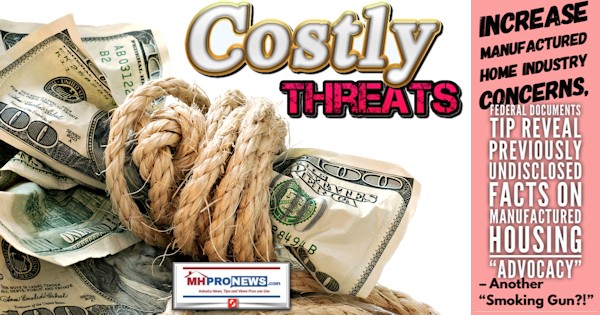
Until next time, learn more in other reports from your only source for authentic “Industry News, Tips, and Views Pros Can Use” © where you demonstrably find consistent “Intelligence for your MHLife.” ©
###

[cp_popup display=”inline” style_id=”139941″ step_id = “1”][/cp_popup]
Now two years ago, but still relevant to this evolving DOE scenario is the prior Masthead linked below.
Stay tuned for more of what is ‘behind the curtains’ as well as what is obvious and in your face reporting that are not found anywhere else in MHVille. It is all here, which may explain why this is the runaway largest and most-read source for authentic manufactured home “News through the lens of manufactured homes and factory-built housing” © where “We Provide, You Decide.” © ## (Affordable housing, manufactured homes, reports, fact-checks, analysis, and commentary. Third-party images or content are provided under fair use guidelines for media.) (See Related Reports, further below. Text/image boxes often are hot-linked to other reports that can be access by clicking on them.)

By L.A. “Tony” Kovach – for MHProNews.com.
Tony earned a journalism scholarship and earned numerous awards in history and in manufactured housing.
For example, he earned the prestigious Lottinville Award in history from the University of Oklahoma, where he studied history and business management. He’s a managing member and co-founder of LifeStyle Factory Homes, LLC, the parent company to MHProNews, and MHLivingNews.com.
This article reflects the LLC’s and/or the writer’s position, and may or may not reflect the views of sponsors or supporters.
Connect on LinkedIn: http://www.linkedin.com/in/latonykovach
Related References:
The text/image boxes below are linked to other reports, which can be accessed by clicking on them.












